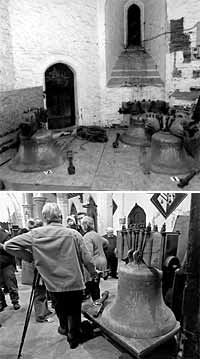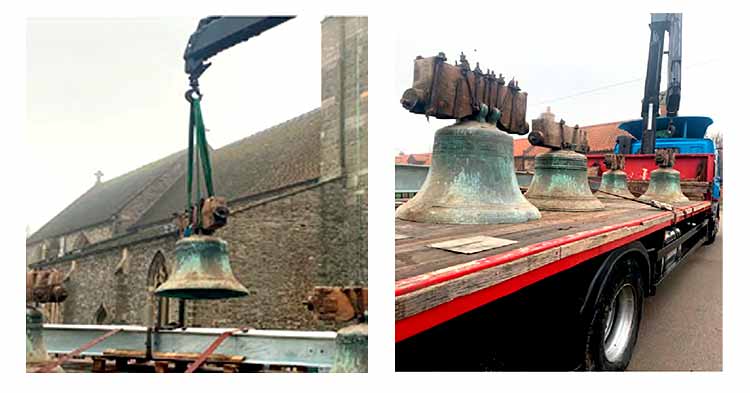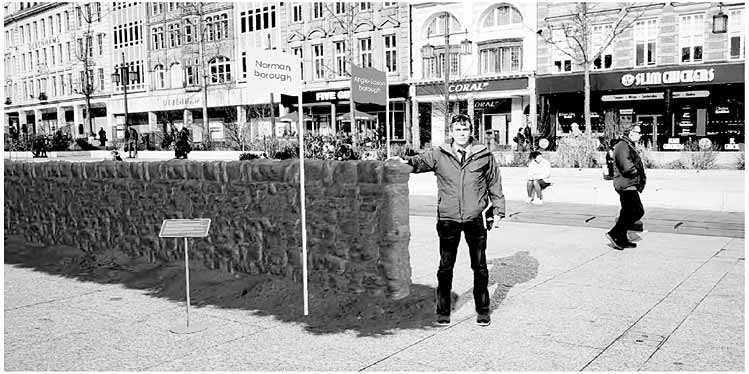News
CAR COLSTON: The Bells! The Bells!

The bells of Notre-Dame Cathedral may have summoned for centuries, until recent times, the people of Paris to worship, and deafened their poor friend Quasimodo, those of the village of Car Colston have remained silent for other reasons.
Damage and decay to the ringing frame and headstocks of the four bells of St. Mary's have forced them to hang silently, requiring the inhabitants to rely on their alarm clocks to ensure timely arrival for services!
On Thursday 1st December 2022, representatives of the Thoroton Society joined with members of the congregation to 'raise a glass' to the bells, prior to their removal to John Taylor & Co. of Loughborough, for some much needed conservation and repair.
The largest and oldest bell dating to c.1480, was made by Richard Mellours of Nottingham, and carries the inscription Clara voce pia resono usa sca maria or I resound with a loud voice of love.
Two were by George Oldfield, also of Nottingham, in the seventeenth century, and the fourth by Taylors of Loughborough in 1872.
On their return to St. Mary's, they will be joined by a fifth, also to be cast at John Taylor's. After the opportunity to inspect them up close, and a few words from the chair of the restoration fund raising committee, the bells were blessed on their journey by the rector, Reverend Ruth Colby. The following morning they were removed to Loughborough; their return eagerly awaited.

Rob James
GEOFFREY BOND AND THE THOROTON RESEARCH AWARDS
AN APPRECIATION OF AN AWARD
We are most appreciative of the Geoffrey Bond and Thoroton Society Research Award that was granted to the ‘Becoming Christian in Midland Britain AD500-1050 Project’. The aim of the project is to better understand the process of the transition from a predominantly ‘pagan’ society to one that was Christian in nature in the early medieval period. The study area is effectively the swathe of historic counties across the English Midlands, approximately equating to that of the Kingdom of Mercia. Ultimately the project will seek to address questions relating to how and why the network of parish churches and other such sites developed. The project draws on archaeological records, architectural and artistic evidence, documentary material and evidence from place-name studies. In addition, consideration will be given to the relationship of our churches to local topography, both natural and human. The grant that was received from the Geoffrey Bond and Thoroton Society Research Awards has contributed towards the work that has gone into the compilation of the data for the Nottinghamshire area. This data is in the format of individual parish records and the Nottinghamshire parish data is currently in the process of being edited. It will then be entered into a searchable database alongside the data from the other counties in the study area.While the focus of the project is the period AD 500-1050, many settlements have evidence of human activity in the surrounding area that substantially predates the study period and this also forms part of our research. A cut-off date of 1291 has been adopted, being the date of the Taxatio of Pope Nicholas I, itself being a record of the parishes that were in existence at that point. Once the parish records for all of the counties in the study area have been completed the next phase of the project will lead towards publication. The project will also have an on-line presence with a website which will host the searchable database and map resources.
Dr Michael Hawkes, BA, MA, MCIfA
Research Associate Becoming Christian in Midland Britain Project
Revealing Nottingham's intangible heritage through augmented reality

History is sometimes selective and important facts can easily be removed from the collective conscience. Few people are likely to be aware that for 700 years after the Norman colonisation in 1068, Nottingham was split into two boroughs: one populated by Normans, the other by Anglo-Saxons. I decided it was important to investigate this subject more with a research project, funded by Nottingham Trent University, titled ‘The city of two towns: Mapping the wall of Nottingham’s French and English Boroughs through location-based technologies to foster a link between local heritage and community engagement.’ The research team digitally re-created the Market Wall that historically divided the Norman borough from the Anglo-Saxon borough in the Old Market Square in Nottingham using digital locative technology (Augmented Reality-AR, Geo Blog). The final goal was to reveal Nottingham’s hidden heritage inviting citizens and tourists to experience the deep roots of the city using a smartphone or tablet. Data collection was finalised to the mapping of all historical architectural and archaeological data into layers, and then investigated and publicly shared using a Website and Geo-Blog. The website was aimed at realising an easy-to-use tool for researchers, historians, and citizens to have access not just to relevant research data and historical maps, but also the possibility to download the ‘Market Wall AR App’. The App and its digital models were created in collaboration with research assistants Gin Rai and Yven Powell of Confetti Institute of Creative Technologies, using research data and georeferenced position of the Market Wall. A gaming and AR engine (Unreal Engine, AR Core) had been used to realise a digital hypothetical model of the Market Wall, a medieval version of the Malt Cross and a punishment tool: the Ducking Stool. The App had all these three AR features equipped with an animation, a recorded voice over with info, and a virtual lectern to enhance the experience of the user with digital storytelling. With AR technology already available on most smartphones, Nottingham citizens and tourists now can easily discover and interact with an important aspect of the city’s history through virtual archaeology. The AR app was launched on 20th June 2022 and created interest in the local and national press and among citizens, with over 200 users in the first week downloading the app from the research website. Feedback confirmed the fact that this relevant part of Nottingham’s history was not yet known, welcoming the possibility to easily learn interesting historical facts while engaging in a ludic activity using AR. The research demonstrated that the development of smartphones and AR technology can create more possibilities to share intangible heritage integrating digital content with our real world. Therefore, digitally enhancing natural environments, the built environment, and heritage sites, AR on smartphones and tablets are extending museums and exhibitions beyond their traditional parameters and possibly also audiences. While investigating and restoring the forgotten yet unique identity of Nottingham, the research took the first step towards the creation of a City Museum of Intangible Heritage.
Website: www.themarketwall.com
Andrea Moneta
TRIBUTES TO DECEASED MEMBERS
John Wilson
John’s death, as Richard Gaunt wrote in the Winter Newsletter, has seen the Thoroton Society lose one of its most committed and unfailing supportive members. His work as Treasurer, Membership Secretary and Editor of the Newsletter over many years was done so efficiently and with painstaking dedication. His briefing to me, when I took over editing the Annual Report and the Newsletter was detailed, easy to understand. He was always at the end of the phone for further advice as I came to grips with developing and continuing the development of these publications.
In the 2022 Spring Newsletter, his wife Janet, gave a full history of John’s life and I do suggest that members refer back to this. She wrote that John joined the Thoroton Society in 1998 and immediately felt “at home”, enjoying the lectures, the outings and the comradeship. His dedicated service to the Society on Council and more recently as a Vice President plus the other many roles he had will be missed. A true servant to the Society who made the time and had the passion to serve in so many ways. Members will miss his humour, his advice, his knowledge and his company at many Thoroton Events and on the Society’s excursions.
Paul Baker
Alan MacCormick
I represented the Society at the funeral of Alan MacCormick at Gedling Crematorium. Although many younger members would not have known him. He was an enthusiastic archaeologist from West Bridgford who was employed for many years at the Castle Museum. He contributed several important reports and articles to Transactions, especially on the subject of Nottingham’s caves. A very large congregation was present to witness his Buddhist Funeral.
Adrian Henstock
Other society news
John Beckett had the following message from Ann Marcombe, (David Marcombe’s widow) about a project of which many readers will be aware: “The Spital project continues, it is 30 years this year and there is still work to be done. Please feel free to pass on the Spital email address spitalchapel@gmail.com to any students and Thoroton members who would like to know how things are going.” Spital is a chapel in Lincolnshire which David and Ann bought three decades ago.